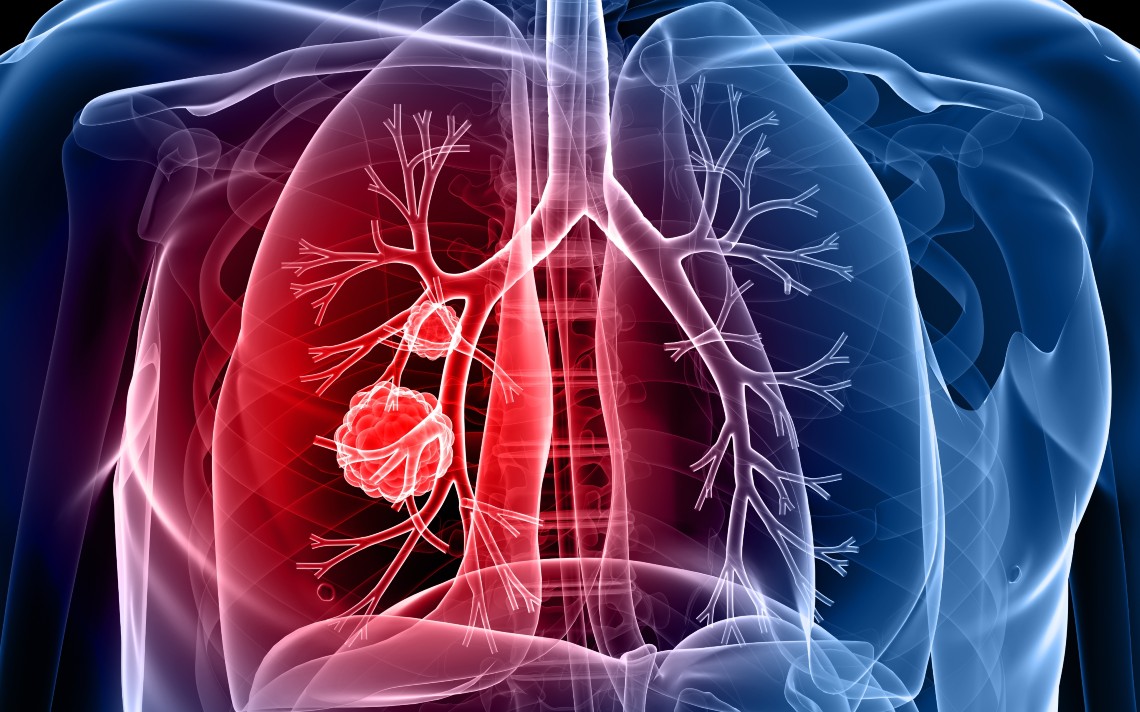Lung cancer is the most common cause of cancer-related death worldwide, of which the vast majority is non-small-cell lung cancer (NSCLC)(1). Early-stage NSCLC can be treated with surgery alone, while later stages are likely to also require adjuvant or combination therapies such as radiotherapy, chemotherapy and immunotherapy. If gene mutations are detected among cancer cells, then targeted therapy could also be administered.
EGFR gene alterations are among the most common mutations in NSCLC, and tyrosine kinase inhibitors (TKIs) are the EGFR-targeted therapies that are most widely known to improve patient outcomes. Third-generation TKIs are the standard of care for patients with EGFR-mutated NSCLC, but, as with most types of lung cancer, disease progression is likely as the cancer cells mutate and become resistant to treatment.
New diagnostic methods and technologies, bispecific antibodies, antibody-drug conjugates, vaccines, and next-generation targeted therapies are all under development to expand the lung cancer treatment landscape.
Earlier treatment decisions via predictive diagnostics
Understanding why patients do or don't respond to immunotherapy could help improve lung cancer outcomes. Predictive biomarker strategies including genetic analysis may be to tailor treatment programs to each patient.
For example, an electronic ‘nose’ technology has shown potential in accurately identifying immunotherapy responders among patients with advanced NSCLC by leveraging a host of volatile biomarkers(2), and researchers have announced a new prediction model that can identify the NSCLC patients who are not likely to respond to immunotherapy(3).
Such forecasting technology could permit non-invasive, low-cost identification of both responders and non-responders at early stages, allowing them to be put on the appropriate treatment program from an earlier timepoint. This would not only improve patient outcomes, but also save money for healthcare systems that might otherwise be spent on ineffective treatments.
With increased collaboration between pharma, healthcare and academia, we can expect predictive systems to become ever more accurate from a growing range of biomarkers. This would allow lung cancer treatment programs to be enacted at earlier and earlier stages in the patient pathway.
Optimized outcomes through tailored and combinatorial treatments
Recent evidence suggests that immunotherapy non-responders have immune cells that can recognize tumors, offering hope for novel treatments that can unlock the cancer-fighting processes and pathways that these patients possess(4).
One such pathway consists of a set of anti-immunosuppressive factors secreted by cells that line the airways known as club cells. The latest research suggests that club cell factors inhibit the high potency immunosuppressive cells that tumors recruit to evade anti-tumor immune responses(5). Combining immunotherapy with a specific dose of radiation can activate these club cells and promote anti-tumor effects in NSCLC patients(6).
Such findings emphasize the potential for personalized, combinatory therapy regimens to expose cancer cells for destruction and enhance patient outcomes, which is of particular importance with the current risk of treatment resistance(7).
Fourth-generation TKIs, along with increasingly accurate predictive models and novel combinatorial approaches, provide hope for maximized tumor eradication across all stages of lung cancer.
If you’re interested in sponsoring a series of medical education meetings around the current NSCLC treatment landscape and future changes, get in touch with our team today: communications@the-corpus.com, where one of our team will be happy to discuss your needs and ideas with you.
References
1. Yuan P, et al. Time-to-Progression of NSCLC from Early to Advanced Stages: An Analysis of data from SEER Registry and a Single Institute. Sci Rep. 2016;27;6:1-9.
2. Buma AIG, et al. eNose analysis for early immunotherapy response monitoring in non-small cell lung cancer. Lung Cancer. 2021;160:36-43.
3. Tunali I, et al. Hypoxia-Related Radiomics and Immunotherapy Response: A Multicohort Study of Non-Small Cell Lung Cancer. JNCI Cancer Spectr. 2021;5:1-11.
4. Caushi JX, et al. Transcriptional programs of neoantigen-specific TIL in anti-PD-1-treated lung cancers. Nature. 2021;596:126-132.
5. Ban Y, et al. Radiation-activated secretory proteins of Scgb1a1+ club cells increase the efficacy of immune checkpoint blockade in lung cancer. Nat Cancer. 2021;2:919–931.
6. Weichselbaum RR, Pitroda SP. Immunoradiotherapy goes club(bing). Nat Cancer. 2021;2:871-872.
7. Wang M, et al. Toward personalized treatment approaches for non-small-cell lung cancer. Nat Med. 2021;27:1345-1356.
Treatment landscapes are constantly evolving and the Lung Cancer therapy area is no exception. In this article, Corpus Content team member Ankur Perry explores the current challenges faced by Oncologists when treating non-small-cell lung cancer, and what future treatment options may look like.
